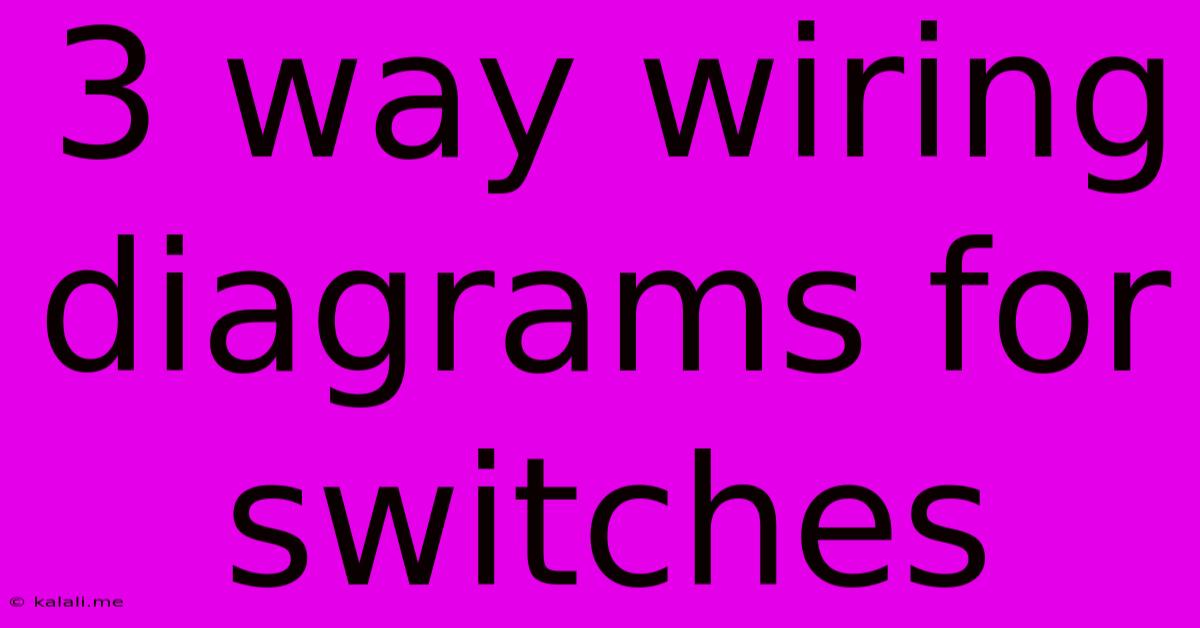3 Way Wiring Diagrams For Switches
Kalali
Jun 07, 2025 · 3 min read

Table of Contents
Decoding 3-Way Wiring Diagrams: A Comprehensive Guide for Beginners
This article will demystify 3-way switch wiring diagrams, providing a clear and concise explanation perfect for both DIY enthusiasts and seasoned electricians. Understanding how these circuits function is crucial for controlling lights (or other devices) from two different locations. We'll break down the process, covering common configurations and troubleshooting tips. This guide assumes a basic understanding of electrical safety and practices. Always turn off power before working with any electrical wiring.
What is a 3-Way Switch?
A 3-way switch allows you to control a light fixture or appliance from two separate locations. Unlike a standard single-pole switch, which has only two terminals, a 3-way switch has three terminals – enabling the control from two points. This setup is incredibly common in hallways, staircases, and split-level homes. Understanding the function of each terminal is key to successful wiring.
Understanding the Components
Before diving into diagrams, let's identify the key components:
-
3-Way Switches: These switches possess three terminals: two common terminals and one traveler terminal. The common terminals are connected to the power source and the load (light fixture). The traveler terminals connect the two switches, allowing the circuit to be completed or broken from either location.
-
Neutral Wire: This carries the return current to the power source. It's crucial for completing the circuit.
-
Hot Wire: This carries the electrical current from the power source to the switch.
-
Load: This is the device being controlled (e.g., a light fixture).
Common 3-Way Wiring Diagrams & Explanations
Several variations of 3-way wiring diagrams exist, depending on the specific setup and regional wiring codes. However, the fundamental principles remain the same. Here are a few common scenarios:
Scenario 1: Basic 3-Way Wiring
This diagram shows the most basic setup controlling a light fixture from two different locations.
(Insert a simple, clear diagram here showing a power source connected to one 3-way switch, then traveler wires connecting to the second 3-way switch, and finally to the light fixture. Clearly label all wires: hot, neutral, travelers, and load.)
In this setup:
- The hot wire connects to one of the common terminals on the first switch.
- The traveler wires connect the two switches.
- The other common terminal on the second switch connects to the light fixture.
- The neutral wire connects directly to the light fixture.
This arrangement allows you to turn the light on or off from either switch.
Scenario 2: 3-Way Wiring with a Switch Loop
This variation introduces a switch loop, which is useful in certain circumstances, like extending the range of the switch control.
(Insert a diagram showing a similar setup as Scenario 1, but incorporating a switch loop that extends the wiring. Clearly label all wires.)
A switch loop adds a little complexity but offers flexibility when dealing with long distances or awkward wiring runs.
Scenario 3: Adding a Dimmer Switch
Integrating a dimmer switch requires careful consideration of compatibility and wiring. Not all dimmer switches are compatible with 3-way circuits.
(Insert a diagram showing a 3-way circuit with one switch replaced with a dimmer switch. Clearly indicate compatibility considerations and any special wiring requirements.)
Troubleshooting 3-Way Wiring
Troubleshooting a malfunctioning 3-way circuit can be challenging. However, systematic checking can help identify the problem. Begin by:
- Checking the power supply: Ensure power is off before starting any troubleshooting.
- Testing the switches: Use a voltage tester to check for power at the various points in the circuit.
- Inspecting the wires: Look for loose connections, damaged insulation, or broken wires.
- Verifying the load: Ensure the light fixture or appliance is functioning correctly.
Conclusion
Understanding 3-way wiring diagrams empowers you to control lighting and appliances efficiently from multiple locations. While seemingly complex at first, the fundamental principles are straightforward. Remember safety is paramount; always disconnect power before working with electrical wiring, and consult a qualified electrician if you are unsure about any aspect of the process. By carefully studying the diagrams and following the steps, you can confidently tackle your next 3-way wiring project.
Latest Posts
Latest Posts
-
Permissions 0644 For Are Too Open
Jun 07, 2025
-
Coefficient Of Static Friction Formula Inclined Plane
Jun 07, 2025
-
How To Make Yellow In Rgb
Jun 07, 2025
-
Donnie Darko 28 06 42 12
Jun 07, 2025
-
Ac Clutch Engages But No Cold Air
Jun 07, 2025
Related Post
Thank you for visiting our website which covers about 3 Way Wiring Diagrams For Switches . We hope the information provided has been useful to you. Feel free to contact us if you have any questions or need further assistance. See you next time and don't miss to bookmark.